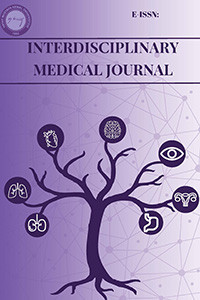KISMİ APOPLEKSİ VE NEKROZ İLE BİRLİKTE SEYREDEN BÜYÜME HORMONU ADENOMU
Pituiter apopleksi yaşamı tehdit eden klinik bir sendromdur. Apopleksi ile birlikte olan kanamalı nekroz literatürde son derece nadirdir. Birçok yazar akut pituiter apopleksinin vasküler adenom içine primer kanamadan ziyade genişleyen pituiter adenomun ani iskemisi, nekrozu ve kanamasının sonucu geliştiğini düşünmektedir. Biz bu çalışmada kısmi apopleksi ile gelişen ve kanamaya bağlı nekrozun eşlik ettiği olguyu literatür ışığında tartıştık.Pituiter apopleksi (PA), yaşamı ciddi tehdit eden klinik bir sendromdur. Bunun nedeni, pituiter kitlenin tümüyle ekspansiyonudur. 1898’de Bailey tarafından rapor edilmiştir. Karakteristik olarak baş ağrısı, bulantı, kusma, görme bozuklukları, 3.sinir parezisi, konfüzyon ve komaya kadar değişen bulgularla kendini gösterir.
Anahtar Kelimeler:
Pituiter apopleksi, büyüme hormonu adenomu, KISMİ APOPLEKSİ
THE COMBINATION OF PARTIAL APOPLEXY AND NECROSIS WITH GROWTH HORMONE ADENOMA
Pituitary apoplexia is a life threatening syndrome of the life. Apoplexia associated with hemorrhagic necrosis is a very rare event in the literature. Many authors think that pituitary apoplexia is a result of the sudden ischemia, necrosis, and hemorrhage due to an enlarging pituitary adenoma rather than a primary hemorrhage into the vascular adenoma. We discussed a case of pituitary apoplexia associated with hemorrhagic necrosis under the light of literature in the present studyPituitary apoplexia is a life threatening syndrome of the life. Apoplexia associated with hemorrhagic necrosis is a very rare event in the literature. Many authors think that pituitary apoplexia is a result of the sudden ischemia, necrosis, and hemorrhage due to an enlarging pituitary adenoma rather than a primary hemorrhage into the vascular adenoma. We discussed a case of pituitary apoplexia associated with hemorrhagic necrosis under the light of literature in the present study
___
- Semple PL, De Villiers JC, Bowen RM, Lopes MB, Laws ER. Pituitary apoplexy: do histological features influence the clinical presentation and outcome? J Neurosurg 2006; 104: 931-7.
- Dubuisson AS, Beckers A, Stevenaert A. Classical pituitary tumour apoplexy: Clinical features, management and outcomes in a series of 24 patients. Clin Neurol Neurosurg 2007; 109: 63-70.
- Wakai S, Fukushima T, Teramoto A, Sano K. Pituitary apoplexy: its incidence and clinical significance. J neurosurg 1981; 55: 187-93.
- Kim JT, Park BJ, Sung JN, Kim YJ, Cho MK : Clinical analysis of pituitary apoplexy. J Korean Neurosurg Soc. 2001; 30 : 724-8.
- Rovit RL, Fein JM. Pituitary apoplexy : a review and reappraisal.J Neurosurg. 1972; 37: 280-8.
- Cardoso ER, Peterson EW. Pituitary apoplexy: a review. Neurosurgery 1984; 14: 363-73.
- Yayın Aralığı: Yılda 3 Sayı
- Başlangıç: 2023
- Yayıncı: Hatay Mustafa Kemal Üniversitesi Tıp Fakültesi Dekanlığı
Sayıdaki Diğer Makaleler
KISMİ APOPLEKSİ VE NEKROZ İLE BİRLİKTE SEYREDEN BÜYÜME HORMONU ADENOMU
M. ALTAŞ, Mustafa ARAS, Zg. ARAS, İhsan ÜSTÜN, Ramazan DAVRAN, Cumali GÖKÇE
OLGU SUNUMU: ADÖLESANDA YÜKSEK DERECELİ SKUAMOZ İNTRAEPİTELYAL LEZYON (HGSİL)
Tümay ÖZGÜR, Sibel HAKVERDİ, Kenan DOLAPÇIOĞLU
Seçil ARICA, Vefik ARICA, Mustafa ARI, Cahit ÖZER
DEMİR EKSİKLİĞİ ANEMİSİYLE LİPİD PROFİLİNİN İLİŞKİSİNİN ARAŞTIRILMASI
Nigar YILMAZ, Hasan ÖZTÜRK, Dudu ERDURAN, Zafer YÖNDEN, Kemal ULUTAŞ
ASEMPTOMATİK BİLATERAL PNOMOTORAKS
Sami DOĞAN, Hakan ATEŞ, Mesut ERBAŞ, Ömür ÖZTÜRK, Suat GEZER, Sami KARAPOLAT
